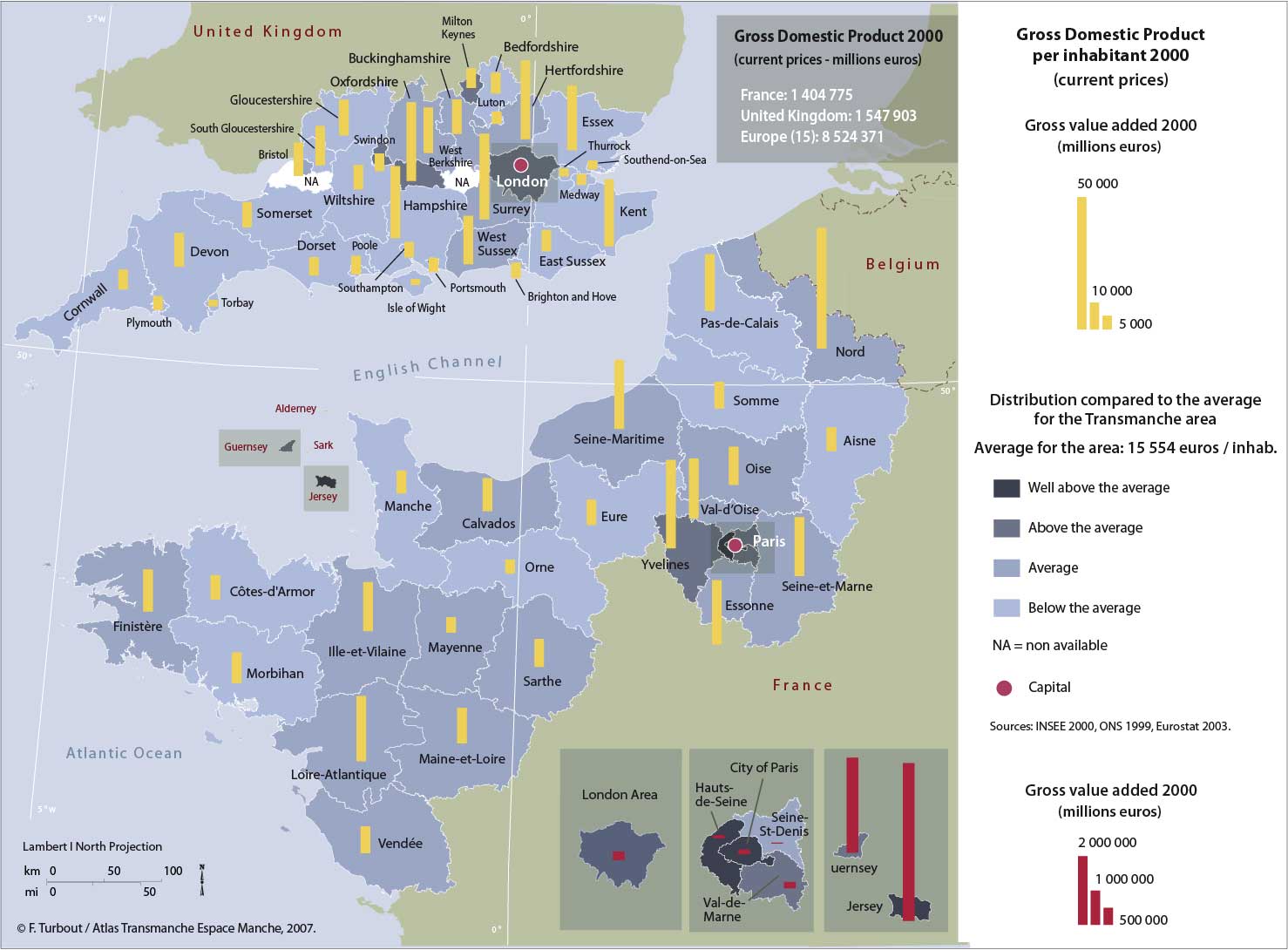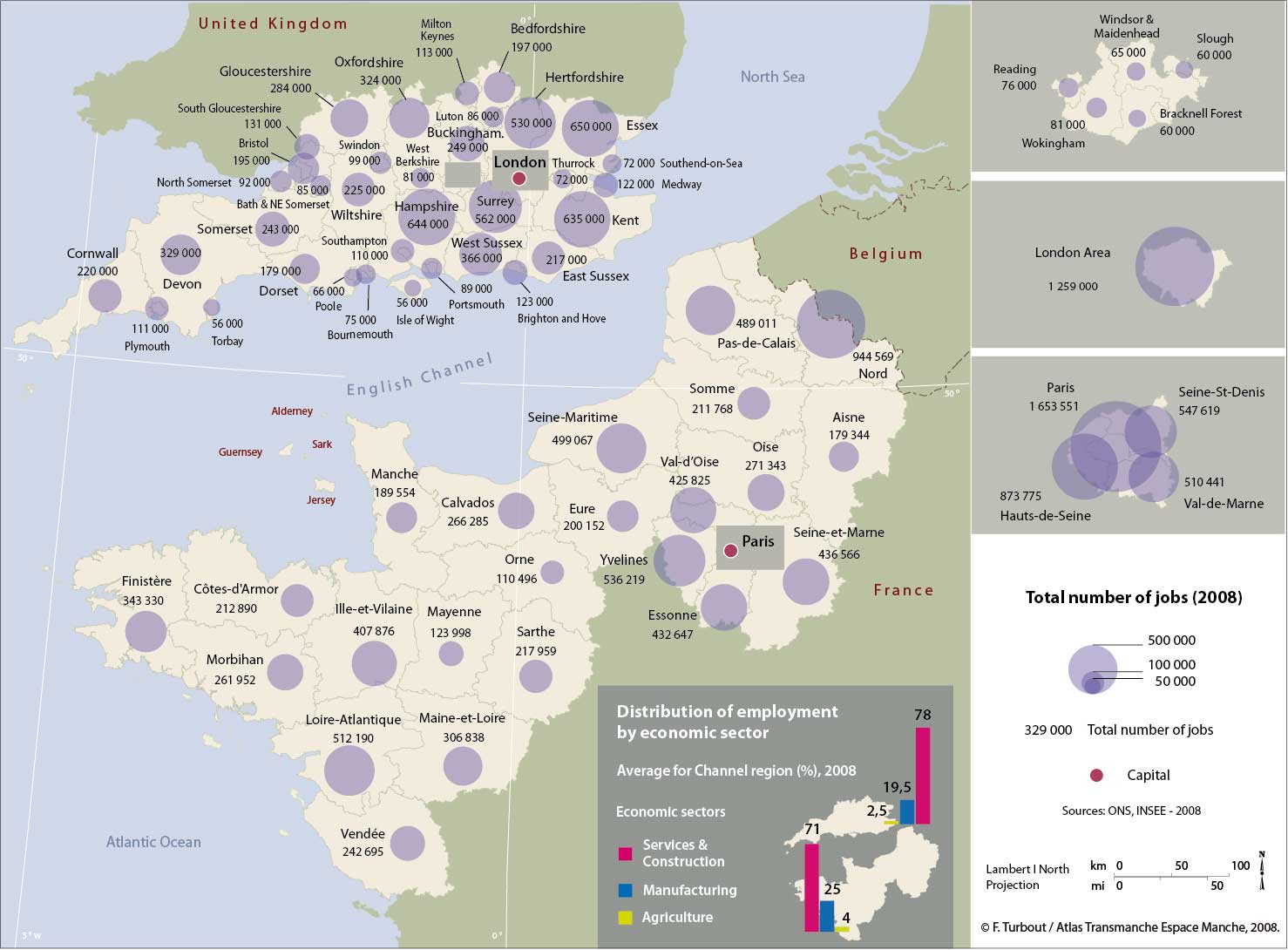

 Activity - Employment
Activity - Employment- Emplois-chômage (2012-2014) FR
- Manufactoring sector (2006)
Ever since the adoption of the classic ‘three sector model' which saw the growing prominence of services as the symbol of economic progress, the tertiary sector has become something of a ‘catch-all.' Post-industrialism produced a vision of a knowledge-based society in which information becomes the main technology used in the production of a good or service. With regional economies becoming more and more service-orientated since the 1980's, this shift from the secondary to the tertiary sector has in turn magnified space demands within the central city as the new employment focus.
The range of activities across the sector itself is very varied, and just as in manufacturing conceals large differences in the Gross Value Added (GVA) contribution to the total economy, with obvious implications for growth potential both within and between regions. In such a context, the high proportion of the working population found in service employment is not in itself a clear indicator of economic vitality. For example, all the counties of the southeast region, economically the most buoyant in the UK, show a very high service sector orientation, up to nearly 80% of all employment. As part of the wealthy ‘Inner southeast,' immediately adjacent to the global city of London, Berkshire and Surrey have particularly high concentrations of private sector service activity. In the ‘Coastal southeast,' the less prosperous periphery, in Kent and East Sussex, it is public sector services that dominate. The division between so-called (‘private') producer services and (‘public') consumer services thus becomes central to any full understanding of current and future trends. In value terms private sector services increased their share of output from just over 40% in 1982 to 55% in 2005, and remain only a couple of % points behind manufacturing in GVA per worker. Producer services are at the leading edge of what has been recognised as a structural shift from manufacturing to service employment in advanced economies.
Clearly the rapid growth of the service sector both sides of the Channel in inextricably linked to the overwhelming presence of the two great primate city regions. Not surprisingly in attempting to map the wider cross-regional influence of these two global economic powerhouses, there is much evidence to suggest an overall east-west gradient as one moves away from both London and Paris. Well beyond their respective catchment areas, the focus on urban centres further down the hierarchy will often influence yet another level of sub-regional variation in economic wealth. This is clearly the case between the two halves of the southwest Peninsula, yet in Truro in the poorer western Atlantic margins of Cornwall, the gap between average house price and average income locally is the highest in Britain! Similar patterns, brought about by the rapid growth of second home ownership by ‘outsiders' are also to be found across the Channel in Brittany and Normandy. These are no longer viewed as anomalies, but rather as part of a more general spatial, social and economic reconfiguration between as well as within regions.
Different economic histories would leave their mark. The ‘Industrial Revolution' in Britain, begun a century before that in France, provided a much earlier stimulus for example to the growth of banking and financial services. Indeed the relative importance of the three economic sectors remained very different until well into the 20th century. By 1900, the population of England was already nearly 80% urbanised (by the middle of the new century, 50% of France's population was still classed as rural). But it is much more recently that national differences in relation to the service sector would arise, when the Thatcher government in the 1980's launched its massive programme of the privatisation of public services, including the national railways, public utilities, healthcare, higher education… As in France, these were the very services that had so long driven the growth of the tertiary sector, but which in Britain would experience major organisational change, the aftermath of which continues to this day. The particular character of local government in each country has further added to important differences. The provision of public sector services in France is arguably geographically more present far down the three well-established levels in the urban hierarchy, not withstanding the higher densities of urban development in Britain.
Yet deregulation of financial markets and the growing specialisation of service outputs is now an established feature in both countries. At the same time, statistical categories have not always helped in analysing growth and change either side of the manufacturing/services divide. Many industries, both large and small, have out-sourced a variety of previously internally-run services from cleaning and IT to maintenance and catering, jobs of course which have not disappeared, but which always needs to be included as a caveat in any comparative analysis. At the more specialised end of this outsourced service provision to firms, it was already apparent in the 1980's in both France and UK that such professional and business services were growing twice as fast as the average for the service sector as a whole. It is why producer services have been seen as warranting separate categorisation. They include market research, accountancy, management consultancy, corporate legal services and insurance, and the like, with industry taking up 60% of such activities in France, underlining the fluidity of the boundary between the two sectors.
In terms of geographical location, ‘face to face' contact is still particularly sought after, above all centrality in relation to markets, clients as well as competitors, and other specialist services. Traditionally, prestige alone continues to make city centres within the core regions of Paris and London highly attractive locations for the ‘front office' activities. But the rising costs of centrality (rents and access) have seen a significant dispersal of producer services into the wider metropolitan region, albeit into established business environments where agglomeration economies already exist. Some do not move far, as was the case with the relocation of the research department of the Banque de France to Marne-la-Vallée. In the wider London region, much earlier moves to neighbouring towns like Reading and Basingstoke have given way to relocations considerably further out as far as the South coast, into accessible, specially designed and landscaped business parks. Often this will involve the ‘back offices' of major service companies engaged in more routine, computerised functions, that do not need to be located in the high cost environments of Central London or Paris.
The strategic importance of the tertiary sector today is seen in its continued growth diversification and development of new areas of activity on both side of the Channel.
top














